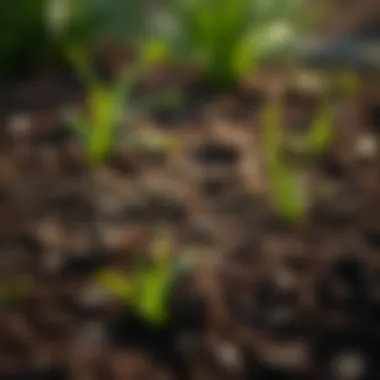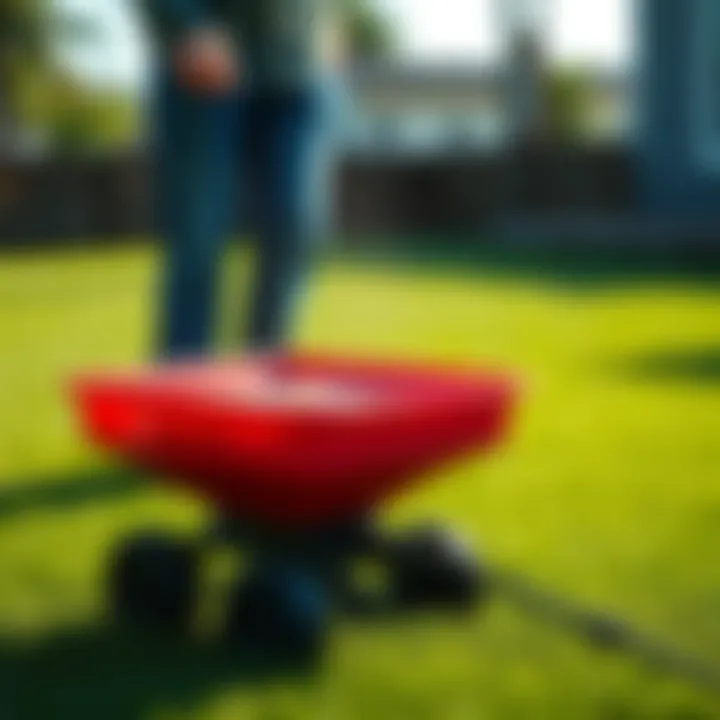A Complete Guide to Spreading Scotts Grass Seed


Intro
Creating a thriving lawn is often seen as the gold standard of gardening. It’s a place to connect with nature, host gatherings, and enjoy relaxation. Among the various options for achieving a lush green yard, Scotts grass seed stands out as a preferred choice for many homeowners. This grass seed boasts several advantages, including the ability to adapt to various climate conditions and soil types. It’s particularly popular for its resilience, making it a worthy investment in your yard.
By delving into this comprehensive guide on spreading Scotts grass seed, you’ll discover not only the ins and outs of preparation and application but also how to nurture your new lawn into a vibrant retreat. Whether you’re a green-thumbed enthusiast or someone just starting their gardening journey, this guide aims to equip you with the necessary techniques and knowledge.
Let’s address not just the ‘what’ but the ‘why’—each step discussed will clarify its relevance, ensuring you have a robust understanding of how to create a lawn that is both beautiful and sustainable.
In the upcoming sections, we will dissect preparation methods, application techniques, and necessary post-seeding care, rounding out with common challenges and solutions to set you on the path toward a garden you can be proud of.
Understanding Scotts Grass Seed
Understanding Scotts grass seed is crucial for anyone looking to fill in bare patches or create a fully new lawn. This understanding encompasses several aspects, not just the types of seeds available but also their benefits and how they contribute to achieving a lush, green lawn. Different varieties of grass seed thrive in different conditions, and choosing the right one can make all the difference. Grasping the nuances of each type helps homeowners make informed decisions that align with their local environment, lawn care goals, and aesthetic desires.
Types of Scotts Grass Seed
When delving into the world of Scotts grass seed, it's essential to highlight the three prominent types available: Perennial Ryegrass, Kentucky Bluegrass, and Tall Fescue. Each brings its own characteristics and benefits that cater to various lawn needs.
Perennial Ryegrass
Perennial Ryegrass stands out for its rapid germination and establishent. This type of grass is a champion for quick patches and is often the go-to for overseeding since it takes root swiftly, filling in those unsightly bare spots within no time. Its fine texture and vibrant green color give a manicured appearance, making it a popular choice among homeowners.
However, it does benefit from regular watering and good soil conditions to really flourish. Perennial Ryegrass can struggle in extreme heat and drought, which may limit its suitability in certain regions. In terms of aesthetics and quick results, though, it remains a first-rate player for lawns looking to look lush and full in a jiffy.
Kentucky Bluegrass
Next up, we have Kentucky Bluegrass, a long-time favorite among gardeners. Known for its lush, dense, and dark green blades, it's often considered the gold standard for lawns. This variety boasts excellent shade tolerance, adding versatility to its appeal.
Kentucky Bluegrass does require a bit more care during establishment. Compared to Perennial Ryegrass, it takes longer to germinate, which can test the patience of eager homeowners. Yet, once rooted, it creates a thick carpet-like lawn that can endure various stresses. Its deep root system makes it fairly drought-tolerant during the growing seasons, though establishing a full lawn might require consistent moisture in the early stages.
Tall Fescue
Last but not least is Tall Fescue, known for its adaptability and resilience. This grass type performs admirably in higher temperatures and has a reputation for excellent drought resistance due to its deep roots. Its thicker, coarser texture offers a different aesthetic that some homeowners prefer.
Tall Fescue is also notable for its ability to handle high foot traffic, making it suitable for families with kids and pets. However, it can take longer to establish and has a tendency to grow in clumps rather than a seamless spread. That might not appeal to everyone, but for practical purposes, its durability shines, especially in less-than-ideal conditions.
Benefits of Using Scotts Grass Seed
The benefits of using Scotts grass seed provide homeowners with incentives to invest time and effort into their lawns. Some of the key advantages include disease resistance, drought tolerance, and quick germination, each contributing to the long-term vitality of a lawn.
Disease Resistance
Disease resistance is one of the major hallmarks of Scotts grass seed. This quality offers peace of mind, knowing that the grass will withstand common ailments like brown patch or fungus. Improved genetics in these seeds helps ensure that the grass can grow out of minor issues without significant intervention.
Choosing a seed with high disease resistance means lower maintenance and reduced need for chemical treatments. It not only protects the investment of time and money but creates a healthier environment for all living beings in your yard.
Drought Tolerance
Drought tolerance, another critical attribute, proves increasingly relevant as climate conditions fluctuate. Grass varieties engineered to withstand dry spells can help conserve water while still maintaining a pristine appearance. Tall Fescue, in particular, excels in this area, allowing homeowners to manage their resources more efficiently without sacrificing the aesthetics of a thriving lawn.
Quick Germination
Lastly, the quick germination of Scotts grass seeds is a boon for anyone eagerly anticipating a lush lawn. Faster germination means less waiting around to watch the grass grow. This speed is not just a matter of impatience; a quicker establishment also allows lawns to compete better with weeds and provides a solid foothold against pests and other environmental stressors.
Preparation for Spreading Grass Seed
Preparing the ground properly before you spread Scotts grass seed is crucial for its successful establishment. This phase sets the stage for everything that follows, directly impacting the seed's germination and healthy growth. A well-prepped lawn not just optimizes conditions for the grass but also saves you time and effort later by preventing common issues like weeds and nutrient deficiencies.
Assessing Soil Quality
Soil pH Testing
A key aspect of soil preparation is conducting a soil pH test. This test measures the acidity or alkalinity of the soil, which can dramatically influence grass seed growth and nutrient uptake. Ideally, grass thrives in soil with a pH between 6.0 and 7.0. If the pH is too low (acidic) or too high (alkaline), one may encounter issues such as iron deficiencies or nutrient lockout. Taking this step ensures you see vibrant green grass rather than troublesome patches. It’s a straightforward process with kits available in garden centers, and the information gained is vital.
Nutrient Composition
The nutrient composition of your soil tells you what it contains – and what it lacks. You'll need to analyze the presence of key nutrients like nitrogen, phosphorus, and potassium. By understanding the macro and micronutrient levels, you know where to adjust fertilization practices. For instance, too much nitrogen can lead to lush grass but weak roots, making your lawn susceptible to diseases. Thus, getting this right provides a balanced foundation for any forthcoming seeding efforts.
Soil Texture


Soil texture affects water retention and root penetration, both of which are vital for your grass seeds to flourish. Whether your soil is sandy, loamy, or clay-heavy determines how easily roots can access water and nutrients. Generally, loamy soil is considered the gold standard for lawns because it holds moisture while draining excess water. If your soil is overly compacted, you might need to employ methods to aerate it before planting. This aspect plays a fundamental role in achieving that lush, green lawn that homeowners aspire to.
Clearing the Area
Removing Weeds
Weeds can be more than just an eyesore; they compete with your grass seeds for essential nutrients and water. Before seeding, it's crucial to remove any existing weeds thoroughly. This can be done manually or with the help of herbicides. The added benefit of a weed-free area is that it allows the grass seed to spread better and establish itself without interference. It’s a fundamental step in preventing future maintenance headaches.
Clearing Debris
Cleaning up the area is also essential. Fallen leaves, sticks, or other debris might block sunlight and hinder seed germination. A clean slate allows your seeds to land directly on the soil, enhancing seed-to-soil contact, which is essential for germination. This step is often underestimated but makes a significant difference in the final outcome.
Tilling the Soil
Tilling the soil helps to loosen it, making it easier for grass roots to penetrate. This practice is especially beneficial if your soil is compacted. By turning the soil, you also promote better aeration and prepare a good seedbed for the new grass seeds. It’s important to not till too deep as this might disrupt existing soil organisms that contribute to a healthy lawn ecosystem. This slight disruption may seem trivial but can lead to long-term benefits for seed establishment.
Choosing the Right Time
Seasonal Considerations
Timing is everything in gardening. Spreading grass seed in the right season greatly affects germination rates and the overall health of your lawn. Generally, early spring or early fall yields the best results for cool-season grasses, while warm-season grasses prefer late spring to early summer. Planting at optimal times allows grass to establish itself before weather stresses kick in.
Weather Conditions
It is equally important to pay close attention to the weather when planning your seeding. Ideally, you want to seed on days when the temperature is neither too high nor too low, and preferably when light rain is forecast, aiding in moisture to settle the seeds. Strong winds can scatter seeds unevenly, leading to patchy areas in your lawn. A little planning can go a long way in ensuring a successful spread.
Optimal Temperature
The optimal temperature helps dictate how quickly grass seeds will germinate. For many cool-season grasses, soil temperatures around 50 to 65 degrees Fahrenheit are ideal. Conversely, warm-season grasses thrive best in temperatures ranging from 70 to 95 degrees. Planning around these temperature parameters can significantly influence seed success, promoting quicker germination and establishment.
Make sure your grass has everything it needs to flourish from the start; it's what separates an average lawn from a breathtaking one.
Techniques for Spreading Scotts Grass Seed
Proper methods to spread Scotts grass seed are critical to establishing a healthy lawn. These techniques not only affect the coverage and seed placement but also influence the overall success of the seeding endeavor. Choosing the right approach can lead to an even, lush lawn, while improper techniques can result in patchy growth or wasted seed. Here, we explore various methods, focusing on their benefits, potential drawbacks, and application specifics to give you a holistic view of best practices.
Hand Spreading
When to Use Hand Spreading
Hand spreading is often best-suited for smaller areas or patchwork jobs, like filling in bare spots or reseeding tight spaces. This method gives the user more control, making it easier to adjust their spread pattern as they go along. It’s particularly useful for homeowners who aren't working with massive lawns. The precision offered by hand spreading is a substantial advantage when addressing specific problem areas in a yard. However, it could be labor-intensive if you have more ground to cover.
Proper Technique
Using the right technique is essential when hand spreading seed. Hold the seed bag with one hand and use your other hand to scatter the seeds evenly across the surface, moving in a back-and-forth or circular motion. This ensures that seeds are distributed uniformly, promoting consistent growth. Another touch is to make two passes across the area - one horizontal and the other vertical. This crisscrossing method helps to avoid gaps in coverage. But beware; it’s easy to overapply in small areas if you’re not careful, causing clumping or overcrowding.
Coverage Tips
To achieve the best coverage, it helps to estimate the seed requirement based on the area size. When you spread, visualize an imaginary grid pattern, ensuring even distribution across the plot. Walk at a consistent pace while maintaining an even strength in your throw. Consider using markers or flags to outline your area, promoting a systematic spread while keeping tabs on spots needing special attention. Remember, slower is better here; it's not a race.
Using a Broadcast Spreader
Types of Spreaders
Broadcast spreaders are a popular choice among homeowners looking to seed larger areas efficiently. These devices come in various types, with the most common being the push-style spreader and the tow-behind type for riding mowers. Push spreaders are maneuverable and cheaper, suitable for tight corners, while tow-behind models cover more ground quickly, great for expansive lawns. Choosing the right type depends on personal preference and lawn size, but both are valuable tools in your seeding arsenal.
Calibration Process
Calibration of your spreader is critical to ensure that you’re applying the seed in the recommended rates. Each type of seed, including different varieties of Scotts grass seed, will require specific settings. The calibration involves adjusting the spreader’s opening based on the seed size and weight, allowing you to achieve uniform distribution. While this may seem tedious, it saves time and frustration in the long run by preventing over-application or waste, keeping your lawn thriving without breaking the bank.
Spreading Methodology
When using a broadcast spreader, the methodology involves walking in straight lines, creating overlapping passes for comprehensive coverage. This prevents streaking and under-seeded patches, promoting an even germination. A methodical approach—such as first moving in one direction and then crisscrossing—helps enhance the overall spread quality. Just make sure to avoid overlapping too heavily, as it can lead to seed competition and poor growth.
Utilizing a Drop Spreader
Advantages of Drop Spreaders
Drop spreaders offer distinct advantages, primarily their accuracy. Unlike broadcast spreaders that can drift seed in undesired directions, drop spreaders place seed directly under the hopper, making application more precise. This is particularly beneficial for yard areas near flowerbeds or landscaping structures. Homeowners often appreciate the control offered by drop spreaders, though they may require some practice to master.


Application Precision
Application precision is a hallmark of drop spreaders. They ensure that seeds land where they are intended without scattering seeds in places where they may not thrive. This controlled approach is especially beneficial for expensive seed varieties or when dealing with new lawngrass that may germinate unevenly if misapplied. It can minimize wasted resources and create a more uniform look across your lawn.
Coverage Rate
The coverage rate for drop spreaders is typically based on the settings you choose, which can be adjusted based on your specific needs. Generally, they cover less area than broadcast spreaders but compensate for this with the improvement in accuracy. Monitoring your coverage rate is essential; be sure to refill your spreader at or near the maximum load to maintain consistency throughout the job. Additionally, calculating ahead of time how much seed you'll need based on your drop spreader's coverage will prevent unnecessary trips.
In exploring these methods for spreading Scotts grass seed, one can appreciate the importance of selecting the right technique appropriate to the project at hand. Consider your specific needs, the layout of your lawn, and your personal comfort with each method. You may find an expert approach to seeding will not only enhance your landscaping but also your gardening satisfaction.
Post-Seeding Care for Success
Post-seeding care is a vital component in the journey to achieve a lush and vibrant lawn. This period directly follows the sowing of Scotts grass seed, where your actions can greatly influence the success of germination and establishment. The right practices during this time help oversee the growth of your seedlings. It involves careful attention to watering, fertilizing, and monitoring growth, shaping the long-term health and vitality of your lawn.
Watering Techniques
Initial Watering
Initial watering following seed application is crucial. It sets the stage for the germination process. Right after you spread the Scotts grass seed, you should moisten the soil carefully. The goal here is to ensure the seed furthers its growth without being washed away. A gentle spraying approach, rather than a forceful torrent, keeps the seed undisturbed. This initial watering helps facilitate the seed-to-soil contact, which is essential in the germination process. Too much water can lead to erosion, while too little can fail to activate the seeds effectively.
Watering Schedule
Establishing a proper watering schedule is key to nurturing your newly planted grass. In general, it's beneficial to water daily for the first couple of weeks. The first two inches of soil should remain somewhat moist but not soggy. After the grass begins to establish, you can reduce the frequency to a couple of times a week, allowing the roots to develop deeper into the soil. Adjusting your schedule according to the weather is also important; if it rains, you can skip a watering session. A well-timed watering schedule promotes steady growth and helps prevent diseases caused by excess moisture.
Signs of Overwatering
Recognizing the signs of overwatering can save you from potential setbacks. A few telltale signs include waterlogged soil and a spongy feel underfoot. Yellowing patches may also emerge alongside a distinct moldy odor. While grass needs water, excessive soaking can stunt growth and lead to root rot. Understanding how to identify these signs allows homeowners to adjust their watering habits promptly, ensuring that their lawn remains healthy and vibrant.
Fertilization After Seeding
Choosing the Right Fertilizer
Selecting the right fertilizer can significantly impact the success of your new lawn. Fertilizers provide essential nutrients that promote vigorous growth. Organic options may be favored by some, providing slow-release nutrients without chemical additives. Others might opt for synthetic fertilizers, as they often deliver nutrients more quickly. Tough decisions aside, choose a starter fertilizer low in nitrogen and high in phosphorus; this combination fosters strong root growth and supports seedlings as they establish.
Application Timing
Timing your fertilizer application is just as important as the product you choose. Right after seeding, many gardeners apply a starter fertilizer to give the germinating seeds a boost. However, it’s advisable to hold off on any additional applications until the grass has established. Generally, waiting four to six weeks after germination will provide sufficient time for the plants to grow sturdy. This thoughtful timing aids in preventing nutrient burn while ensuring that the young grasses receive what they need at critical moments.
Nutrient Requirements
Understanding the nutrient requirements of your newborn lawn can help tune your care routine. Essential nutrients include nitrogen, phosphorus, and potassium. Each plays a unique role; nitrogen supports leaf development, phosphorus strengthens roots, and potassium enhances overall resilience. It’s wise to conduct soil tests before applying fertilizers to tailor the nutrient mix specifically catered to your soil type, avoiding unnecessary waste and expense while gearing your lawn for successful growth.
Monitoring Growth Progress
Identifying Germination
Being able to identify when your seeds germinate is pivotal. You should start seeing tiny blades of grass popping up within a week to ten days, depending on the species of seed used. Early signs of life can help you gauge how well your preparation and post-seeding care have worked. Take note of the growth pattern and density; sparse patches may indicate issues needing addressing. Keeping an eye on germination can inform future watering and fertilizing decisions too, empowering you to create a thriving greenspace.
Managing Weeds
Weed management becomes crucial as your grass takes root. These pesky invaders can compete for water and nutrients, potentially stunting grass growth. Early intervention can prove beneficial; manual weed pulling or light application of pre-emergent herbicides can help control weed populations. Regular monitoring allows you to swiftly act against any unwanted growth that threatens your lawn's health, ultimately leading to a richer and leafier lawn.
Adjusting Care As Needed
Flexibility in your care routine is essential. As you monitor the growth progress, be prepared to adjust your practices. If you notice slow growth, consider altering your watering or fertilization strategy. On the flip side, respond to environmental changes, such as sudden temperature drops or rising disease risks, by modifying your care regime. Staying observant and adaptable ensures your lawn continues thriving, even in the face of challenges.
Common Issues and Solutions
When it comes to establishing a lush lawn, spreading Scotts grass seed can sometimes face hurdles. A well-rounded understanding of these potential roadblocks and how to navigate them is essential for success. This section dives into common issues homeowners may encounter and offers practical solutions to ensure a thriving lawn.
Dealing with Unsuccessful Germination
Potential Causes
Unsuccessful germination can leave a lawn looking more like a patchy jungle than a plush green carpet. The reasons behind this can vary widely. Environmental factors such as inadequate moisture or extreme temperatures often play a significant role. Likewise, soil quality is crucial; compacted soil or improper pH can inhibit seed growth. Seed quality too matters; old or improperly stored seed may not germinate at all. The permeability of soil impacts water retention and ultimately, root establishment. Understanding these factors helps gardeners identify issues and take corrective measures effectively.
Remedial Actions
Once the root cause of unsuccessful germination is identified, remedial actions can be taken to rectify the situation. Soil amendments—such as adding organic matter—can help improve soil structure and nutrient levels. Changing the watering schedule may also help; a consistent, light watering often yields better results than infrequent heavy watering. Consideration of temperature regulations is key as well. If it's too hot, shade cloths might be used to provide some respite, while colder conditions might require insulating covers for seedlings. Addressing these areas can significantly enhance germination success.


Reapplication Strategies
Should initial attempts at seeding fail, reapplication may be necessary. Timing is important when choosing to reapply. Wait until conditions are optimal for growth, and consider using a different variety of grass if the first choice didn’t work out. Broadcasting seed again can fill in any bare spots; however, proper technique must be followed to prevent over-seeding. Thinning out existing grass may also be wise before reapplication, as overcrowding can choke young seedlings—therein comes the advantage of selecting the right species for your lawn's unique conditions.
Pest Control in New Lawns
Identifying Common Pests
As your lawn grows, it may attract a multitude of pests that threaten its development. Common pests like grubs, chinch bugs, and armyworms can wreak havoc if left unchecked. Regular inspections of your lawn can aid in lasting damage. The telltale signs include brown patches or irregular spots that don’t respond to watering. Identifying these pests is crucial, as different types require distinct approaches to manage effectively.
Preventive Measures
Preventing pest infestations is usually better than curing them. Healthy soil and robust grass are your first lines of defense. Employing practices like crop rotation or planting companion species can deter pests naturally. Maintaining correct mowing heights and not over-fertilizing are also effective preventive strategies. It reduces pests’ chances of establishing themselves in a thriving, dense lawn environment.
Treatment Options
If your lawn does attract unwanted guests, treatment options vary from cultural practices to chemical applications. Utilizing natural insecticides made from neem or garlic can serve as an eco-friendly answer for pest problems. For severe infestations, however, synthetic pesticides may necessary. It's essential to follow guidelines on application strictly to avoid damaging the young grass. Thus, reading and understanding product labels becomes indispensable in this process.
Managing Environmental Factors
Temperature Fluctuations
Temperature can swing drastically from day to night, affecting grass seeds’ success. Day extremes can dry out the soil, while nighttime cold might hinder growth. Finding the sweet spot often means knowing when to plant—preferably during stable weather months. Pay attention to the forecast; avoid seeding if unexpected fluctuations are predicted.
Moisture Levels
Water management becomes crucial in keeping moisture levels balanced. Not too little, to starve the seeds, and not too much, to create a drowning scenario. Understanding soil drainage and the area’s local climate helps in findng that balance. If moisture fluctuates too much, utilizing hydrogel amendments can encourage retention, acting like a buffer against extremes in weather.
Sunlight Exposure
Finally, sunlight plays an indispensable role. Grass seedlings require full sun to germinate properly. Consequently, knowing where sunny spots and shade areas are on your property informs your application strategy. Tall trees or structures may necessitate rethinking planting areas, perhaps choosing more shade-tolerant varieties for those regions where sun exposure is lacking. Regular assessment concerning light exposure will empower you to make timely adjustments for optimal growth.
Through understanding these common challenges and implementing practical solutions, homeowners can ensure their Scotts grass seeds flourish, paving the way for a stunning lawn.
Ending and Long-term Maintenance
In any gardening endeavor, understanding the keys to sustaining your lawn over the long haul is paramount. This section encapsulates the essence of your journey with Scotts grass seed. From initial seeding to green, luscious growth, the approach doesn't stop after germination. In fact, the secret to a flourishing yard lies in consistent care and diligence. The relationship you build with your lawn through careful monitoring and maintenance can mean the difference between a drab stretch of yard and a verdant oasis.
Evaluating Lawn Health
Regular Observations
One of the most vital aspects of lawn care is Regular Observations. This practice allows homeowners to catch potential issues before they burgeon into larger headaches. By routinely inspecting your lawn, you can readily identify problems such as pest infestations, nutrient deficiencies, or early signs of disease. The unique characteristic of this form is its simplicity; a quick walk around the yard can reveal much. Regular Observations serve as an essential tool for keeping your lawn thriving, and it doesn’t require any fancy equipment.
"An ounce of prevention is worth a pound of cure"—this adage rings especially true for lawn maintenance.
Using Regular Observations fosters familiarity with your grass's needs, and helps you develop a tailored care strategy, making it a popular choice among enthusiasts.
Adaptation to Seasonal Changes
Weather has its say when it comes to maintaining a lush lawn, and therefore Adaptation to Seasonal Changes is crucial. As temperatures shift, so do the requirements of your grass. In spring, your lawn may crave additional nitrogen, while summer could present a necessity for increased watering. This adaptability ensures that your lawn continues to receive the right care at the right time, bolstering your efforts for a sustainable landscape.
The beautiful aspect of recognizing seasonal changes is that it highlights the intersection of nature and human intervention. Grounding your approach in natural cycles allows you to foster healthier grass. Adaptation isn't merely beneficial; it's an ongoing conversation between you and the environment.
Lawn Recovery Techniques
Life happens; sometimes your meticulously sown seeds may take a beating from a harsh storm, pests, or even heavy foot traffic. Lawn Recovery Techniques are about reviving your effort. Utilizing methods like overseeding, reseeding, and focusing on proper watering can help recover damaged areas and promote uniform growth. This strategic work enables your lawn to bounce back rather than remain an eyesore.
A notable feature of these techniques is their accessibility. Most homeowners can implement basic recovery strategies without professional help, making them a practical choice. The downside may be that recovery can take time, but persistence pays dividends.
Sustaining Lawn Vitality
Mowing Practices
The way you mow can significantly impact your lawn's overall health. Establishing effective Mowing Practices can help maintain the right height for grass types, which encourages deeper root growth and better moisture retention. A key characteristic of proper mowing is sharp blades; they create clean cuts, reducing damage to your grass. Regularly mowing can also keep weeds at bay, allowing a more robust lawn to thrive.
Investing in effective Mowing Practices also brings the added benefit of aesthetics. A well-manicured lawn enhances property curb appeal, making it a practical choice for homeowners seeking to increase their property value.
Seasonal Fertilization
When it comes to promoting vigorous growth, Seasonal Fertilization is a non-negotiable. The nutrients that plants derive from fertilization vary throughout the year; hence adjusting your approach based on seasons is critical. A key feature of this process is the timing; applying fertilizers too early or late can lead to inefficiencies or even harm. The unique benefit of Seasonal Fertilization is that it creates a nutrient-rich environment for your grass, promoting overall vitality and resilience.
Nonetheless, one must be cautious of over-fertilizing, which can lead to undesirable growth patterns or environmental runoff. Tailoring fertilization schedules according to specific grass needs is essential for sustainable practice.
Aeration and Overseeding
Finally, the tandem act of Aeration and Overseeding is an intrinsic element of lawn sustainability. Aeration alleviates soil compaction, allowing water and nutrients to reach the roots effectively. Following through with Overseeding introduces new grass varieties to the lawn, enhancing density and diversity.
The beauty of Aeration and Overseeding lies in the improvement of your lawn's resilience against diseases and environmental stressors. It’s a beneficial practice that mimics natural systems at work. The drawback, perhaps, is the labor intensity involved; however, the long-term gains significantly outweigh the initial efforts.





